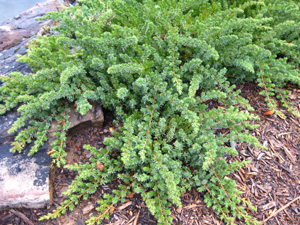Resource Library
Plant of the Week: Shore Juniper
The University of Arkansas System Division of Agriculture does not promote, support or recommend plants featured in "Plant of the Week." Please consult your local Extension office for plants suitable for your region.
Plant of the Week
Shore Juniper
Latin: Juniperus conferta

Groundcovers are the Rodney Dangerfields of the plant kingdom: they don’t get no respect. Everyone wants showy and flashy and seem less than interested in the mundane, work-a-day plants that just quietly go about their lives doing their thing. Shore juniper (Juniperus conferta) is one of these widely used and dependable plants that should get more respect amongst gardeners.
Shore juniper is a horizontal-growing evergreen reaching 16 inches tall with a spread of six feet or more if given sufficient time. It has a dense, procumbent growth form with main stems trailing out sideways, but with lateral branches ascending upwards from the main branch. In its native habitat of Hokkaido, the northernmost island of the Japanese archipelago, it grows in sand dunes, so this growth form allows it to survive in a blowing and shifting sand environment.
It has quarter-inch long, awl-shaped evergreen needles that terminate in a prickly point. The leaves are glaucous green, with a deep groove on the upper surface that is lighter in color than the rest of the leaf. ‘Blue Pacific’, a clone that has been around since the late 1960s, is the form most likely found in nurseries. Its foliage is softer to the touch than the species and more blue than green in color.
Being a conifer, there are no significant flowers. The three-eighths-inch diameter berry – actually a cone because junipers belong to the conifer class – is blue to blackish brown and covered with a heavy waxy bloom.
Shore juniper was introduced into the United States in 1915 by E. H. Wilson (1876–1930), one of the world’s most famous and productive plant explorers. “China” Wilson, as he was known during the heyday of his collecting career during the first decade of the 20th century, first worked for England’s Veitch Nursery and then was hired away to collect for the Arnold Arboretum in Boston.
In 1910, Wilson was nearly killed in a landslide in western China, and from that time on his collecting expeditions became decidedly less risky. Between 1912 and 1918, he made many trips to Japan, often taking his wife and daughter. During the 1915 trip to the cold and blustery Hokkaido, he collected living material of shore juniper. His most significant introduction for Arkansas gardeners were the 50 evergreen azalea clones he introduced in 1918 from the city of Kurume on Kyushu, the most southern of the three main islands of Japan.
Shore juniper is an excellent groundcover for most landscape situations in the southeastern United States. It works well on steep slopes and in raised beds where the branches are allowed to cascade over the edge. As a groundcover, shore juniper is easier to maintain than really prostrate selections of J. horizontalis, such as ‘Blue Rug’ or ‘Bar Harbor’, because the extra height of shore juniper makes it more difficult for competing plants such as bermudagrass to become established.
Though best in full sun, it will tolerate light shade better than most other junipers. It requires reasonable drainage, but I have it growing in compacted clay that few other plants would tolerate. It appears to grow about as well in alkaline or acidic soil conditions. Like all junipers, shore juniper has great drought tolerance once established. Plants are hardy from zones 5 through 10.
‘Blue Pacific’ is the most common clone grown and one of the best. ‘Silver Mist’ has a more silvery color and a more compact habit. ‘All Gold’ is a new golden foliage form that will be more common in coming years.
By: Gerald Klingaman, retired
Retired Extension Horticulturist - Ornamentals
Extension News - January 27, 2012
The University of Arkansas System Division of Agriculture does not maintain lists of retail outlets where these plants can be purchased. Please check your local nursery or other retail outlets to ask about the availability of these plants for your growing area.